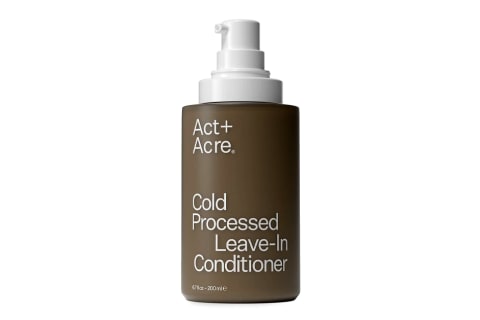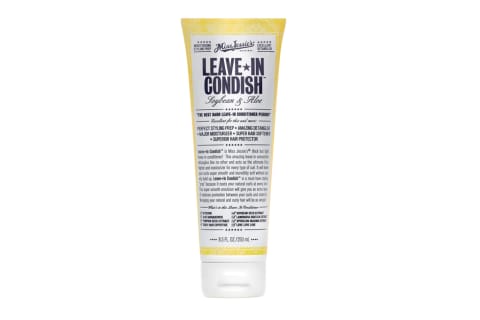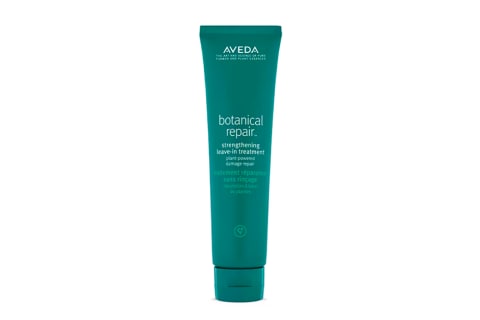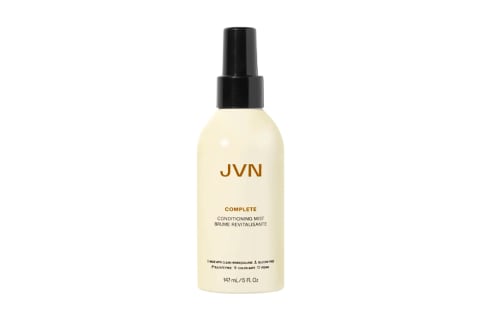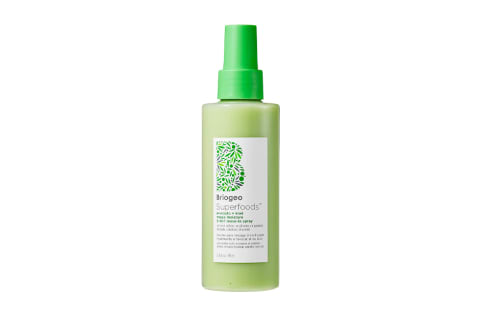How To Use Leave-In Conditioners, From The Pros + A DIY Recipe


With skin care, how you use products is even more important than the specific formulas you choose. Take retinol serums, for example: If you overdo it, use too much, or don't use it often enough, you'll have trouble getting the results you're looking for—the same goes for hair care.
While leave-in conditioners may sound self-explanatory, there's certainly a method to reap all of their wonderful benefits. To follow, hair experts explain exactly what to do—and what to avoid—when it comes to leave-in conditioner. Let's get into it.
What is a leave-in conditioner?
"Simply put, a leave-in conditioner is usually of a lighter viscosity and weight than a mask and is left in the hair pre- or post-styling," lead hairstylist and co-founder of DESIGNME Amy Stollmeyer tells mbg.
These products are used to restore hydration, increase shine, aid the detangling process, and even provide other benefits such as heat and UV protection, Stollmeyer says. Think of it like a hair mask that's formulated to be left in. (Hence the term, leave-in conditioner.)
But just like hair masks and traditional in-shower conditioners, these products aren't just preventive—they can help to treat existing damaged ends, nourish brittle hair, and deeply hydrate dried-out strands.
Unlike hair masks that you'll use once a week or so, these leave-ins should be used after every wash. "[Think of it as] the first step in your styling routine," certified trichologist, celebrity stylist, and founder of scalp-first hair care brand Act + Acre Helen Reavey notes.
Leave-in 101:
How to apply leave-in conditioners
Now that you know what leave-in conditioners do, let's dive into the best way to use them for maximum benefit:
- Apply on damp hair as needed
- Use the appropriate amount for your hair type
- Detangle
- Style as usual
Apply on damp hair as needed
Right after you step out of the shower, whether you did a full wash or just a quick rinse, apply at least a quarter-sized amount of leave-in conditioner to your damp strands.
Apply from the mid-shaft of your strands all the way to the ends. If you have any leftover product, apply that to the top of your strands near the root to reduce frizz and flyaways.
Many leave-in conditioners contain humectants, which are hydrators that pull water into your hair—think hyaluronic acid, glycerin, etc.—which is why applying to damp hair is highly encouraged. However, you can apply them to dry hair as well—more on that in a bit.
Know how much leave-in conditioner to use
Your hair texture will determine how much leave-in product to use. In general, coarser hair types generally need a bit more product than finer hair. Here's what Reavey recommends with the Act + Acre Cold Processed Leave-In Conditioner:
- For fine hair, use one pump (which is about a quarter-sized amount).
- For medium-textured hair (not too fine, not too coarse), use two to three pumps.
- For coarse hair, four or five pumps will provide the best hydration.
As with any hair product, experiment with your leave-in conditioner the first few times you use it to determine how much you need for deep hydration and how much is too much.
If you've applied a bit too much for your hair type, your strands may feel weighed down or have trouble holding a style—so let that be your telltale sign to dial it back.
On the flip side, if you feel like your product isn't providing enough hydration, try using a larger amount and see if that helps.
In addition: Where you apply it matters, too. Most folks should avoid applying it too close to the root. Trichologist Bridgette Hill has an excellent tip to help: "If you have hair with length, flip your hair over as if you were going to be applying a loose ponytail. The hair thats from the start of the ponytail to the ends are the fibers you want to coat with a leave-in."
Detangle hair as needed
If you choose to brush or comb your hair, a leave-in conditioner provides a necessary buffer to give the strands more slip. "Leave-in conditioners and detanglers are pretty much synonymous," hairstylist and cosmetologist Faith Huffnagle, director of education at Prose, tells mbg about using detangler. See, when your hair is dried out, it can be much harder to sort through tangles and thus, combing or brushing may lead to more breakage.
After you've applied your leave-in conditioner, slowly and gently sort through each section of your hair with a comb, brush, or your fingers if that's more your speed. Try your best to avoid ripping through tangles or brushing the hair too quickly, as both can lead to manual damage.
Style
This last step is all up to you and how you prefer to style your hair. If you're going for a heatless style, you can scrunch your strands to encourage uniform curls, let it air-dry, diffuse your curly strands, or opt for a blowout—the options are endless.
No matter what you choose, your style will look even better with the extra dose of nourishment from a leave-in—after all, the more care you put into your hair, the kinder it will be to you in return.
Who should use a leave-in?
So, should everyone use leave-in conditioner? The short answer is yes, but it gets a bit more nuanced depending on hair type and porosity—here's what the pros want you to know.
Hair type
"The product typically works for all hair types," Reavey says. "But [it] specifically targets concerns such as dryness, frizz, or damaged hair, working particularly well for wavy and curly textured hair to add some definition to the curl."
- Coarse, dry, or curly: Those with dry, coarse, or curly hair may benefit more from a thick, creamy formula, as it will contain rich plant butters and emollients that soften the hair.
- Fine or straight: On the flip side, those with straight or superfine hair may want to look for something with a gel-like texture, as a product that is too rich may weigh down the strands.
This is why some leave-in conditioners are specifically designed for curly or straighter hair types. But the average leave-in will be somewhere right in the middle.
"The formulations are deeply hydrating and often contain lightweight ingredients that have been specially formulated to leave all hair types feeling silky and soft without any added weight," Reavey says.
mbg pro tip:
Porosity
Another factor to consider is how porous your strands are. "Hair porosity describes how the hair's cuticle absorbs and holds on to moisture in its pores—hence, the term porosity," hairstylist Miko Branch, co-founder of hair care brand Miss Jessie's once told mbg.
If you're not sure how porous your hair is (it can be confusing!), here's a quick test:
- Start with freshly washed, dry hair that has no additional product on it.
- Drop a strand into a glass of water in a tall glass.
- Next, note if it drops to the bottom or floats.
If it floats, you have low porosity hair. If it sinks to the bottom, you have high porosity. If it's somewhere in the middle, you have medium or normal porosity.
For those with low porosity hair, it's even more essential to apply leave-in conditioner thoroughly and consistently, as your hair might have a harder time absorbing and holding on to water and products.
This is just the top-line info—for a deeper dive into hair porosity tips and tricks, check out this guide.
Style needs
If you want to let your hair dry and take its natural form, then leave-in conditioner can serve as a way to elevate the shape and provide nutrients to your strands.
- Tame frizz. While there's absolutely nothing wrong with frizzy strands, oftentimes frizz can mean your hair is dehydrated—especially if it happens on occasion or seasonally. If your goal is to tame frizz, whether it be on your natural hair or a heat-styled look, leave-ins will work wonders.
- Style primer. Think of it like your skin right after you apply a hydrating serum or rich moisturizer—it looks plumper and helps your subsequent products glide even better.
- Extra protection. Plus, there are plenty of factors that dry out the hair, from weather to heat damage and more—so giving your hair a little extra TLC is never a bad idea.
Ingredients to look out for.
When it comes to searching for the best product, there are a few particularly nourishing ingredients to keep in mind. These include:
- Humectants like glycerin, aloe vera, and hyaluronic acid
- Nourishing emollients like shea butter or avocado butter
- Plant oils like meadowfoam seed oil, argan oil, jojoba oil, and cannabis sativa seed oil
- Antioxidants from vitamin E, CoQ10, botanicals, and fruit extracts to protect from oxidative stress
It's important to note that some leave-in conditioners contain non-water soluble silicones that can build up on the hair and scalp, leading to increased strand dryness and scalp inflammation. (However, there are options that are water soluble, which don't really come with the same risks.) So if you think your product is leading to buildup, try switching to a silicone-free formula—the Act + Acre Leave-In Conditioner is one A+ option (among others, which we recommend below).
How are leave-ins different from other hair care products?
Leave-ins are a unique category in beauty, but they do share a lot of overlap with other products.
- Oils: Leave-in conditioners are usually emulsions, which means they contain a mix of liquids, butters, waxes or oils. Oils on the other hand are simply that, lipids. Oils can be pure or a blend. Pure oils are not mixed with any other kinds of oils, and common examples are pure coconut, sunflower seed, or jojoba oil. Blended oils come in a wide variety, and tend to be what you get when you purchase a conventional hair oil.
- Serums: Leave-ins and serums are very similar, and in some cases may be one in the same. However, serums tend to be thinner in viscosity and may contain more potent ingredients. Serums can also target the scalp, whereas leave-in conditioners are only for the hair fiber.
- Curl creams and products. There may be some overlap between curl products and leave-in conditioners, as many leave-ins are formulated for curly hair. Additionally, some curl products fall more into the gel, wax, pomade, or cream category. So some curl products can be leave-ins. And some leave-ins also act as curl products. But not always!
- Conditioners. The difference here is simple: Conditioners and masks you rinse out in the shower, whereas a leave-in conditioner is applied after and stays in.
DIY leave-in options.
If you want to experiment with a silicone-free DIY leave-in, whip up this recipe in a bowl and apply it to your strands using a spray bottle:
- 2 tablespoons aloe vera—it can be fresh from the plant or a pure store-bought gel. (Just make sure it's 100% pure and free of fragrances and dyes.)
- 3 tablespoons water
- 1 tablespoon jojoba oil
Or if you want something even easier, you can take a tablespoon of your favorite conditioner, mix it with a few tablespoons of water to reach a milky consistency, and spray that onto your strands.
Depending on your hair type, the latter option may feel a bit heavy (read: might not be the best for straight, fine hair). You can play around with the measurements, adding a bit less conditioner and a tad more water if you find the blend weighing down your strands.
Styling tips for leave-ins.
If your hair needs some extra moisture, you can use leave-in conditioner more often—and not just post-wash. Here are a few ideas:
Refresh curls between washes.
As mentioned before, curly hair types often need extra moisture. If you find your curls don't hold their shape between washes, it may be due to dehydration. Take a quarter-sized amount of leave-in conditioner and run it through your hair to revive curls and restore bounce.
A healthy slicked-back look.
Slicking back your hair with an ultra-sticky hair gel can lead to increased dryness—so opt for a nourishing product instead. Leave-in conditioners rich in plant butters and oils can help you achieve a slicked look, sans damage.
To tame flyaways.
On dry hair, "You can [apply] half a pump to instantly refresh hair and smooth frizz and flyaways on dry hair," Reavey says. This will help hold the hair in place without leaving a greasy residue like some concentrated hair oils might.
On the ends to manage splits.
If you're prone to split ends, using a pea-sized amount of leave-in conditioner on your tips (wet or dry) will add nourishment and help prevent more splits.
Best leave-in conditioners
FAQ
When should you apply a leave-in conditioner?
Right after you step out of the shower, whether you did a full wash or just a quick rinse, apply at least a quarter-sized amount of leave-in conditioner to your damp strands. On dry hair, you can use a leave-in conditioner to tame flyaways, aid in slicked-back styles, or revive dried-out curls.
Can you use leave-in conditioners every day?
Yes. Leave-in conditioners contain nourishing ingredients that can be beneficial to the hair when used every day. Especially if you wash or rinse your hair daily, you should apply a leave-in conditioner every day.
Can I use leave-in conditioner on dry hair?
Yes, you can use leave-in conditioner on dry hair. This will provide the strands with additional moisture and nutrients to keep your hair looking fresh and tame flyaways. For those with curly or wavy hair, leave-in conditioner can help refresh the shape and restore bounce between washes.
The takeaway
As you can tell, there's much more to leave-in conditioners than meets the eye. Use these nourishing products post-shower to restore hydration, keep curls bouncy, and even protect against heat damage. Plus, you can use them on dry strands for extra nourishment or for a healthier slicked-back look. Ready to shop? Here's our curated list of the best clean and natural options to get you started.
Also check out how to use a standard conditioner here.

Hannah Frye is the Assistant Beauty & Health Editor at mindbodygreen. She has a B.S. in journalism and a minor in women’s, gender, and queer studies from California Polytechnic State University, San Luis Obispo. Hannah has written across lifestyle sections including skin care, women’s health, mental health, sustainability, social media trends, and more. She previously interned for Almost 30, a top-rated health and wellness podcast. In her current role, Hannah reports on the latest beauty trends and innovations, women’s health research, brain health news, and plenty more.
